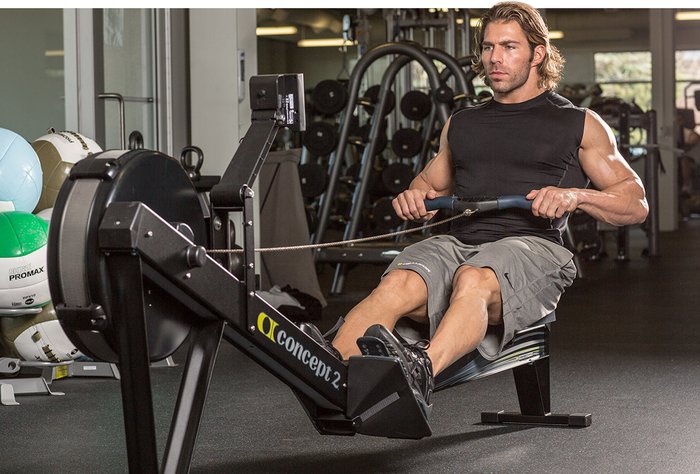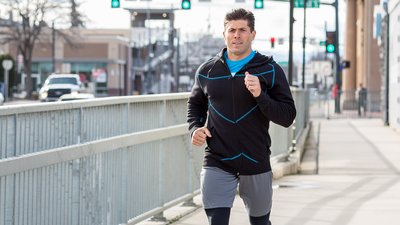"Cardio kills gains" has long been a mantra within the lifting community. Some bodybuilders cling to this notion so tenaciously that they think climbing two flights of stairs can shrink a 270-pound man into a 120-pound weakling.
It's true that muscle adaptations differ greatly in response to aerobic training versus resistance exercise. The more you train for one, the harder it will be to reach the same level in the other. Compare a marathon runner to Kai Greene for proof.
But that doesn't mean aerobic and resistance training are completely incompatible.
When programmed correctly, cardio can help improve your results, your body composition, and your overall health.
Can You Do Cardio And Still Have Muscle Growth?
Decades ago, it was shown that 10 weeks of cardio plus resistance training interfered with muscle growth relative to resistance training alone.[1] However, if you take a closer look at the training volume used in that study—six days a week of cardio plus five days a week of strength training—you can see it was quite high. Few of us today are going to be doing 30-40 minutes of cardio six days week.

Performing cardio 2-3 days a week seems to be the sweet spot for complementing your training gains without putting your muscle at risk.
More recent research suggests that moderate amounts of cardio can actually boost the effects of strength training. Studies have shown that resistance training coupled with 2-3 days of cardio can lead to greater gains than strength training alone.[2,3]
The takeaway here is that there seems to be a "Goldilocks" blend of cardio and resistance training. Too much cardio can interfere with muscle growth—but so can too little. Performing cardio 2-3 days a week seems to be the sweet spot for complementing your training gains without putting your muscle at risk.
Order Is Important
Muscular adaptations to both aerobic and resistance training can compete and potentially interfere with each other, so it's critical you allow enough time between sessions to minimize interference and optimize performance and subsequent adaptations.[4,5]
Strength impairments following high-intensity or endurance exercise can last up to 6 hours, so it makes the most sense to separate sessions by at least that long.[2,6,7] Conversely, if you wait too long, you may start experiencing some of the soreness from your earlier workout. That's because muscle soreness has a delayed onset. Try and find the sweet spot: long enough after a session to minimize interference, but soon enough that this delayed-onset muscle soreness (particularly from a lower-body workout) won't affect the quality of your training.
In terms of order, the difference between the two may not be hugely important. A few studies examining adaptation from resistance training before aerobic training or vice versa found that improvements in muscle strength and size weren't affected by exercise order.[8,9]

Strength training plus cycling can improve muscle size more than strength training alone!
From a practical perspective, it's likely that fatigue from a strength-training session will affect your subsequent cardio session less than the reverse. Taken one step further, would you rather be tired doing a 3-rep max on a squat or on a 3-mile run? I'll take the latter, please.
Everyone's different, though. Experiment with workout order and timing to find out what fits your schedule and benefits your performance.
Mode Matters
Compared to other forms of cardio, running causes a lot of muscle damage—most likely due to the large amount of eccentric muscle contractions involved in the movement. Cycling, however, places more emphasis on concentric muscle action. This may cause less overall damage, ultimately limiting the amount of interference with recovery and muscle growth.
Running for hours probably isn't the best idea, but lower-impact activities like cycling may improve your results in the weight room. Several studies have shown that strength training plus cycling improved muscle size more than strength training plus treadmill walking, or strength training alone.[3,10]
The Bottom Line
Cardiovascular exercise offers some major health benefits, including improved aerobic capacity. But the benefits extend to your lifting as well. Cardio can give you a higher work capacity during your gym session, allow for quicker recovery between both sets and sessions, improve your body composition, and essentially keep you from collapsing going up a few flights of stairs.

Separate training sessions by at least 6 hours to minimize interference and optimize results.
The timing and overall volume of cardio and strength training seem to be the biggest factors in designing a successful concurrent training program.
Huff And Puff: Use Cardio To Support Your Gains
- Adopt strategies that increase cardio but minimize overall volume (e.g., HIIT 2-3 times a week).
- From a practical perspective, performing cardio first may affect the quality of your strength training more so than the other way around.
- Separate sessions by at least 6 hours to minimize this interference and optimize results.
- Cycling as opposed to running seems to be more beneficial in terms of complimenting training gains.
How To Incorporate Cardio Into Your Lifting Schedule
Sample Workout Plan 1
- Monday a.m.: Lower Body
- Monday p.m.: Stationary Bike—8-10 sets of 1 min. on, 1 min. off. Start with a 5-min. warm-up and finish with a 5-min. cool down. ("On" means going all out—the last 10-15 seconds of your interval should have you gasping for air.)
- Tuesday: Upper-Body Push
- Wednesday: Off
- Thursday a.m.: Lower Body
- Thursday p.m.: Stationary Bike—10-mile time trial (Complete 10 miles as fast as possible, and aim to improve this time each week.)
- Friday: Upper-Body Pull
Sample Workout Plan 2
- Monday: Upper-Body Push
- Tuesday: Upper-Body Pull
- Wednesday a.m.: Lower Body
- Wednesday p.m.: Stationary Bike—30 minute Tempo ride (Aim for the highest intensity you can maintain for the entire 30 minutes.)
- Thursday: Off
- Friday: Upper-Body Push
- Saturday: Upper-Body Pull
- Sunday a.m.: Lower Body
- Sunday p.m.: Rowing Machine—6-8 sets of 400 meters as fast as possible, followed by a recovery row of 200 meters. (Start with a 5-min. warm-up and finish with a 5-min. cool-down.)
References
- Hickson, R. C. (1980). Interference of strength development by simultaneously training for strength and endurance. European Journal of Applied Physiology and Occupational Physiology, 45(2-3), 255-263.
- Lundberg, T. R., Fernandez-Gonzalo, R., Gustafsson, T., & Tesch, P. A. (2013). Aerobic exercise does not compromise muscle hypertrophy response to short-term resistance training. Journal of Applied Physiology, 114(1), 81-89.
- Mikkola, J., Rusko, H., Izquierdo, M., Gorostiaga, E. M., & Häkkinen, K. (2012). Neuromuscular and cardiovascular adaptations during concurrent strength and endurance training in untrained men. International Journal of Sports Medicine, 33(9), 702-710.
- Sale, D. G., MacDougall, J. D., Jacobs, I., & Garner, S. (1990). Interaction between concurrent strength and endurance training. Journal of Applied Physiology, 68(1), 260-270.
- Baar, K. (2014). Using molecular biology to maximize concurrent training. Sports Medicine, 44(2), 117-125.
- Häkkinen, K., Alen, M., Kraemer, W. J., Gorostiaga, E., Izquierdo, M., Rusko, H., ... & Romu, S. (2003). Neuromuscular adaptations during concurrent strength and endurance training versus strength training. European Journal of Applied Physiology, 89(1), 42-52.
- Bell, G. J., Petersen, S. R., Wessel, J., Bagnall, K., & Quinney, H. A. (1991). Physiological adaptations to concurrent endurance training and low velocity resistance training. International Journal of Sports Medicine, 12(4), 384-390.
- Eklund, D., Schumann, M., Kraemer, W. J., Izquierdo, M., Taipale, R. S., & Häkkinen, K. (2016). Acute endocrine and force responses and long-term adaptations to same-session combined strength and endurance training in women. The Journal of Strength & Conditioning Research, 30(1), 164-175.
- Cadore, E. L., Izquierdo, M., dos Santos, M. G., Martins, J. B., Lhullier, F. L. R., Pinto, R. S., ... & Kruel, L. F. M. (2012). Hormonal responses to concurrent strength and endurance training with different exercise orders.The Journal of Strength & Conditioning Research, 26(12), 3281-3288.
- Gergley, J.C., (2009). Comparison of two lower-body modes of endurance training on lower-body strength development while concurrently training. Journal of Strength & Conditioning Research, 23(3), 979-987.

